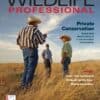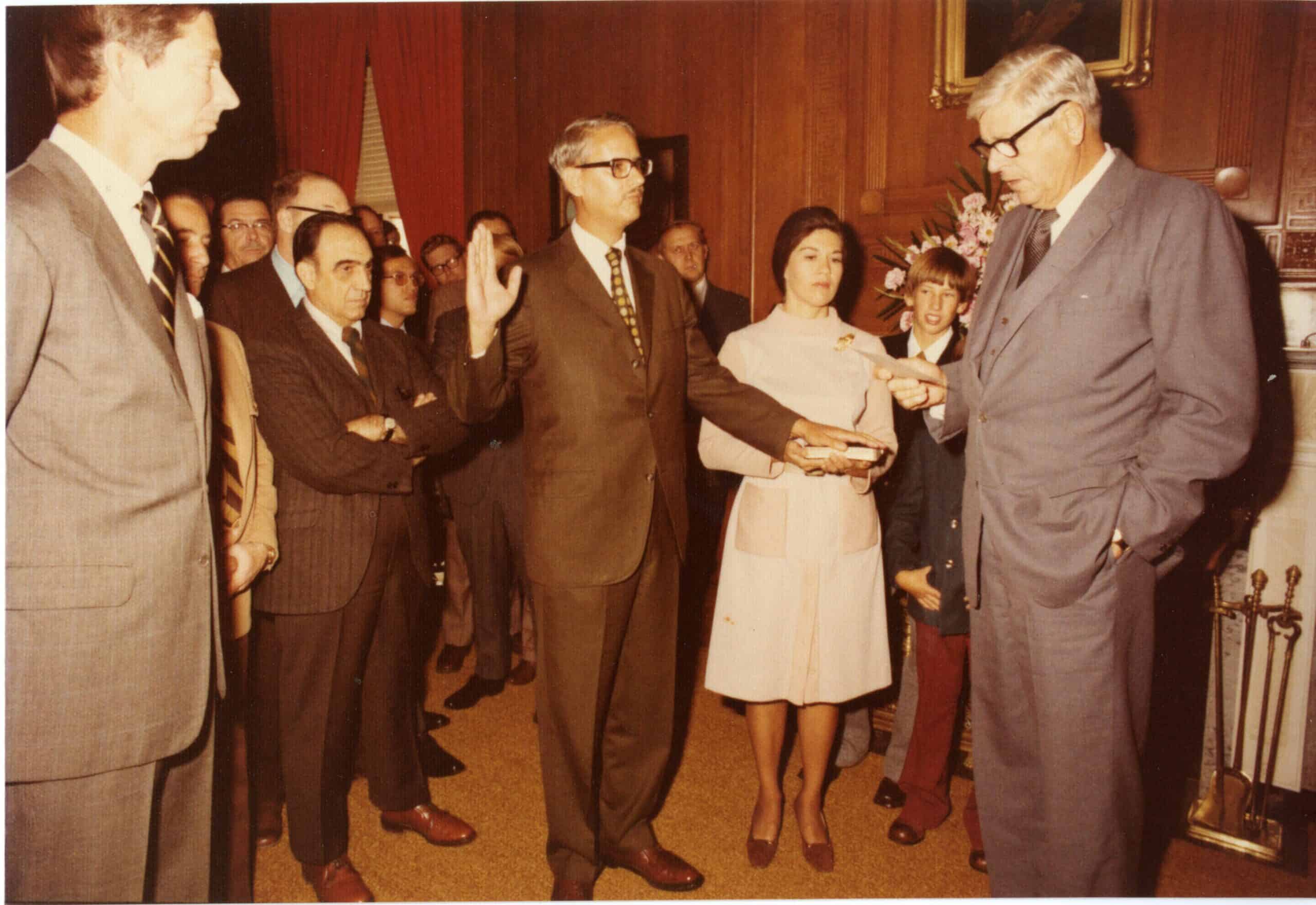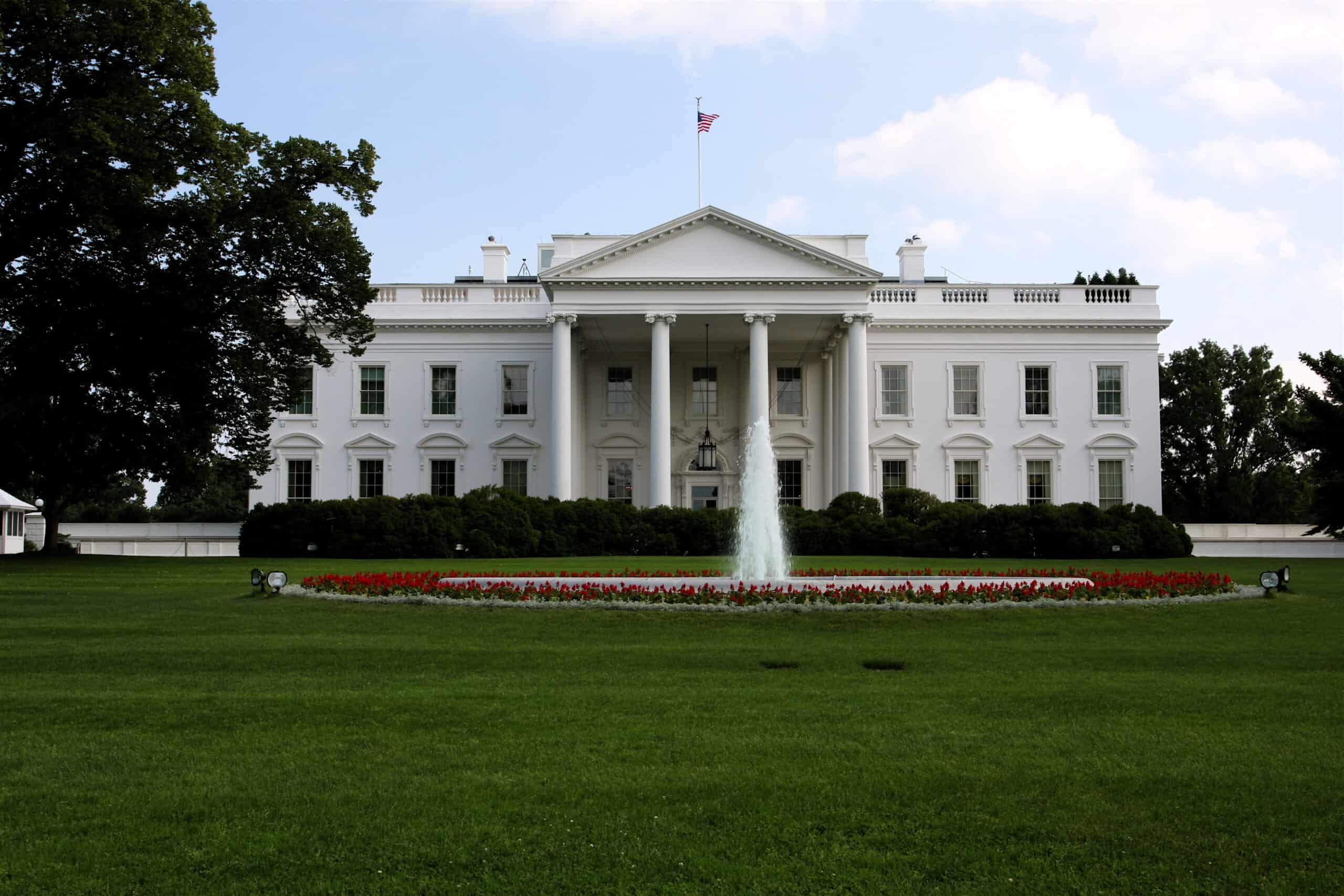Share this article
What the DOGE is happening?
After weeks of federal agency layoffs—and more on the horizon—you may be wondering how we got here and what could happen next
For over a century, the federal government has served as a consistent foundation in North American wildlife conservation on public lands and beyond. Today, even the smallest shift in that foundation has far-reaching repercussions. It can influence what research agencies fund and what studies researchers published. It can also affect talent recruitment and staff capacity for implementing management actions on public lands. Human nature leads us to assume that our current federal governance structures for wildlife conservation initiated during the same era as the founding of The Wildlife Society will continue. However, many are starting to realize that recent changes—expected and unexpected—in the federal government have already altered that reality for wildlife conservation.
President Trump has kicked off his second term at a blistering pace, signing at least 73 executive orders in one month. Whether you support or oppose the changes he’s making, there’s no denying the shockwaves that have reverberated through the wildlife community. Moreover, the speed at which the administration is making these changes has resulted in mass confusion about what’s happening and uncertainty about what comes next.
If you have found yourself trying to make sense of it all, know that you are not alone. While I don’t have all the answers, I hope sharing what I do know and my perspectives on what comes next will help you contextualize the shift we’re seeing across the entire executive branch of the federal government.
Finding clarity amidst the noise
While you have undoubtedly read many of the news headlines, I suspect you are still befuddled by the endless twists and turns in the form of daily courtroom rulings and contradictory outcomes (e.g., is federal funding frozen or not?). This is purposeful and directly linked to the new administration’s often-stated outcome: a dramatic reduction in the size of the federal government. So, how do you make sense of what you’re seeing? And how can you regain a sense of what the future holds, when new changes are seemingly implemented on a daily basis? For me, it comes down to finding certainty amid the disruption by looking at intent and what we can reasonably expect comes next.
This does not mean we should completely withdraw from the dialogue around what’s going on today. Rather, we should understand that the need for our work persists even if the foundation around us has changed. Looking at President Trump’s executive orders provides a roadmap for what his administration is seeking to accomplish. These documents have created the Department of Government Efficiency (DOGE), and the administration is using these orders to justify terminating employees, cutting funding and shuttering entire agencies. Once you view the true purpose and intent of each order, all the noise created by the tactics and politics begins to fade. You may not like the intent—in fact, the intent may harm you—but you will at least have some clarity and insight into what might happen next.
In reviewing President Trump’s executive orders to date, every TWS member should be aware of the following:
Executive Order 14148 of Jan. 20, 2025 – Initial Rescissions of Harmful Executive Orders and Actions – Rescinds 68 executive orders and 11 memoranda from the Biden Administration that focus primarily on the government’s approach to climate change, the environment, COVID-19, ethics and diversity, equity and inclusion (DEI). Specifically, it directs the heads of each agency to “take immediate steps to end federal implementation of unlawful and radical DEI ideology.” Targeting positions and programs around DEI for cuts is efficient for the administration, given the prevalence of DEI work across the federal government and beyond. Further, by emphasizing DEI and the framing of DEI work as “unlawful and radical,” the administration is likely intending to divert attention away from other significant budget cuts and policy changes. The Wildlife Society continues to recognize the value of including the richness of human diversity in our efforts to discover, educate, inform policy, and involve the public in wildlife science and management as reflected in our Position Statement on Workforce Diversity in the Wildlife Profession.
Executive Order 14151 of Jan, 20, 2025 – Ending Radical and Wasteful Government DEI Programs and Preferencing – Orders the Office of Management and Budget (OMB) and the Office of Personnel Management (OPM) to terminate “all discriminatory programs, including illegal DEI and ‘diversity, equity, inclusion and accessibility’ (DEIA) mandates, policies, programs, preferences and activities in the federal government, under whatever name they appear.” This applies to all positions, trainings, committees, programs, services, activities, budgets, expenditures and federal grants related to DEI, DEIA and “environmental justice.” Like the first referenced order, this order establishes a broad foundation for the administration’s cuts, especially when combined with a subsequent executive memorandum that directs “the heads of executive departments and agencies to review all funding that agencies provide to NGOs … [to] align future funding decisions with the interests of the United States and with the goals and priorities of my administration, as expressed in executive actions.” As of the date of this article, a district court judge issued a nationwide, preliminary injunction preventing the Trump Administration from implementing this order because it may infringe upon First and Fifth Amendment rights protected by the U.S. Constitution.
Executive Order 14153 of Jan. 20, 2025 Unleashing Alaska’s Extraordinary Resource Potential – States that it is now the policy of the United States to “fully avail itself of Alaska’s vast lands and resources” and “efficiently and effectively maximize the development and production of the natural resources located on both federal and state lands within Alaska.” It also orders the Secretary of Interior and other relevant agencies to “rescind, revoke, revise, amend, defer or grant exemptions from any and all regulations, orders, guidance documents, policies and any other similar agency actions that are inconsistent with the policy.” The order does not explicitly mention the use of the best available science nor does it describe how decision makers will incorporate scientific evidence. Given the order’s emphasis on specific action without consideration of the best available science, this could result in agencies ignoring science that contradicts a desired outcome, which would conflict with TWS’ Position Statement on the use of Science in Policy and Management Decisions.
Executive Order 14154 of Jan. 20, 2025 – Unleashing American Energy – Primarily aims to promote energy and mineral exploration and production on federal lands and waters, including the Outer Continental Shelf. Like the previous order, it focuses on eliminating regulatory barriers. The order also attempts to terminate key climate funding that Congress previously approved by immediately pausing the “disbursement of funds appropriated through the Inflation Reduction Act of 2022.” In addition to other directives for eliminating subsidies favoring electric vehicles and other energy-efficient technology, the order references the scope and integrity of the scientific process several times. The order describes prioritizing environmental analyses by adhering “to only the relevant legislated requirements for environmental considerations” using “robust methodologies” that are not “arbitrary or ideologically motivated.” This narrows the scope of what science may be used and carefully avoids the use of terms like “best available science,” which carry legal meaning through regulations and years of established case law. It also has strong potential to politicize science by introducing an ideological review component to what science may be considered in environmental analyses. The order then disbands the Interagency Working Group on the Social Cost of Greenhouse Gases and withdraws as government policy several reports and technical documents related to greenhouse gas monitoring and the social cost of greenhouse gases. Lastly, the order contains a policy statement, “to guarantee that all executive departments and agencies provide opportunity for public comment and rigorous, peer-reviewed scientific analysis.” While seemingly innocuous, TWS did see specific peer-reviewed studies opened up for public comment during the first Trump Administration (read our comments here). As a result, TWS will monitor how agencies interpret this policy to ensure the terms “public comment” and “peer-reviewed” are not conflated as a way to promote alternative facts with no empirical or theoretical support that cast doubt about sound scientific information, which would again conflict with TWS’ Position Statement on the use of Science in Policy and Management Decisions.
Executive Order 14156 of Jan. 20, 2025 – Declaring a National Energy Emergency – Gives the Secretary of the Interior and other relevant federal agencies the authority to use emergency provisions under the Endangered Species Act (ESA) to the “maximum extent permissible” to facilitate the nation’s energy supply. This means that the Secretary can suspend or modify enforcement of certain ESA regulations to expedite energy-related projects and activities. The order instructs the Secretary of the Interior, as chairman of the Endangered Species Act Committee, to convene the committee no less than quarterly to “review and consider any lawful applications … for exemption from obligations imposed by Section 7 of the ESA.” In the event that the committee has no pending applications for review, the committee is still charged with convening to “identify obstacles to domestic energy infrastructure specifically deriving from implementation of the ESA or the Marine Mammal Protection Act.” So, even when no one submits applications for ESA exemptions, the “God Squad,” as it’s often referred to, will still convene to assess the removal of obstacles created by the country’s key laws for the protection and recovery of imperiled species. While TWS does not oppose balanced energy siting and development processes, viewing species listings as a barrier to expedited energy development runs counter to several of TWS’ position statements focused on environmental quality and the conservation of biological diversity.
Executive Order 14158 of Jan. 20, 2025 – Establishing and Implementing the President’s “Department of Government Efficiency” – Establishes the United States Department of Government Efficiency Service (DOGE) as a temporary organization within the executive office of the president, replacing the existing United States Digital Service. The order places a DOGE team of at least four individuals within each agency to “implement the president’s DOGE agenda.” While the focus of this order is on IT efficiency and data interoperability, reference to the “DOGE agenda” is widely regarded to mean recommendations for substantial cuts to the federal budget. The order directs agency leaders to give DOGE full and prompt access to all unclassified agency records, software systems and IT systems. This temporary organization will terminate on July 4, 2026.
Executive Order 14162 of Jan. 20, 2025 – Putting America First in International Environmental Agreements – Directs for the immediate withdrawal of the United States from the Paris Agreement and other international climate commitments made under the United Nations Framework Convention on Climate Change (UNFCCC). This includes immediate revocation of any purported financial commitment that the U.S. made under the UNFCCC. Moving forward, the policy of the Trump Administration will be to “put the interests of the United States and the American people first in the development and negotiation of any international agreements with the potential to damage or stifle the American economy.” This order runs counter to the policy of The Wildlife Society regarding global climate change, wildlife and sustainability, which calls for greater emphasis on intergenerational and cultural equity, effective dissemination of climate change information, broad engagement of experts in climate change research and stronger actions to reduce greenhouse gas emissions.
Executive Order 14192 of Jan. 31, 2025 – Unleashing Prosperity Through Deregulation – Seeks to shrink the regulatory framework of the United States by requiring that “whenever an executive department or agency publicly proposes a new regulation for notice and comment or otherwise promulgates a new regulation, it shall identify at least 10 existing regulations to be repealed.” Further, it requires all agencies “to ensure that the total incremental cost of all new regulations, including repealed regulations, being finalized this year [FY25] … be significantly less than zero.” This could soon have significant effects on environmental regulations through the elimination of various protections and standards related to air and water quality, forever chemicals, endangered species, migratory birds and more. It’s also a precursor for a much wider-ranging deregulatory effort outlined below.
Executive Order 14210 of Feb. 11, 2025 – Implementing the President’s “Department of Government Efficiency” Workforce Optimization Initiative – “This order commences a critical transformation of the federal bureaucracy” that is likely to have major impacts on the federal workforce beyond the recent “fork in the road” deferred resignation program or termination of probationary employees. Specifically, it asks agencies to identify “any statutes that establish the agency, or subcomponents of the agency, as statutorily required entities” by March 13, 2025, as a way to identify “whether the agency or any of its subcomponents should be eliminated or consolidated.” In this same timeframe, the order also directs the OPM to initiate rule-making that would expand OPM’s ability to make suitability determinations on federal employees. Currently, OPM’s ability to implement suitability actions, or the cancellation of eligibility or removal of an employee from a position, is limited to nine factors focused primarily on lawful behavior. However, the contemplated rulemaking seeks to add new, more subjective considerations to the list for OPM suitability actions, including failure to comply with generally applicable legal obligations, failure to comply with provisions that would preclude regular federal service, and refusal to certify that they have not restricted an employee from disclosing gross waste of funds or misuse of government resources. With these new factors in mind, the recent efforts of OPM to exert greater oversight on federal employees (e.g. “What did you do last week?” email) makes more sense as it establishes a potential basis for OPM suitability actions. The order also instructs agencies to “promptly undertake preparations to initiate large-scale reductions in force (RIFs), consistent with applicable law, and to separate from federal service temporary employees and reemployed annuitants working in areas that will likely be subject to the RIFs.” Lastly, in “reforming the federal workforce to maximize efficiency and productivity,” the order instructs all agencies to make hiring decisions in consultation with DOGE and requires “that each agency hire no more than one employee for every four employees that depart.” As already outlined in our memorandum to members on Feb. 19, professional, science-based management requires the appointment and hiring of professionally competent individuals capable of dealing with the complexities of modern management and science into wildlife agencies at all levels. The Wildlife Society is deeply concerned by any reductions in the federal workforce that limit an agency’s ability to appropriately develop and use science in policy and management decisions.
Executive Order 14219 of Feb. 19, 2025 – Ensuring Lawful Governance and Implementing the President’s “Department of Government Efficiency” Deregulatory Initiative – Instructs all agencies, in coordination with DOGE, to “commence the deconstruction of the overbearing and burdensome administrative state” by identifying regulations to modify or rescind based on seven factors. These factors include but are not limited to unlawful delegations of legislative power, no underlying statutory authority, and costs that outweigh public benefits or cause harm to national interests. Agencies are instructed to prepare these lists by April 20, 2025. The Administrator of the Office of Information and Regulatory Affairs will then “develop a Unified Regulatory Agenda that seeks to rescind or modify these regulations, as appropriate.” This order opens the door for large-scale changes in how the government operates and may potentially affect things like the definition of habitat under the Endangered Species Act, permitting processes under the Migratory Bird Treaty Act, the definition of navigable waters and regulation of Concentrated Animal Feeding Operations under the Clean Water Act, and various climate-focused regulations. With many core environmental laws dating back to the 1970s, much of the evolved regulatory framework that now supports wildlife conservation could be in question if this executive order remains in effect.
Executive Order 14222 of Feb. 26, 2025 – Implementing the President’s “Department of Government Efficiency” Cost Efficiency Initiative – Focuses on federal spending, contracts, grants, loans and property. This includes the immediate review of all contracts and grants for termination or modification to reduce overall federal spending and to “advance the policies of [the] administration.” This administration will complete this review by March 28, 2025. During this time, they will freeze all agency employee credit cards. The order also labels conference travel as nonessential and states that each “agency head shall prohibit agency employees from engaging in federally funded travel for conferences or other nonessential purposes unless the travel-approving official has submitted a brief, written justification for the federally funded travel,” which will be reviewed by DOGE and posted publicly. Finally, the order directs agencies to submit a plan to OMB for “the disposition of government-owned real property which has been deemed by the agency as no longer needed” by April 27, 2025. This order has obvious financial repercussions for TWS as the organization receives financial support from several government agencies. Federal employees also make up a large chunk of our annual conference attendance. However, the biggest area of concern from this order is the vague language and lack of exceptions around the potential divestiture of public lands. TWS will watch closely how the agencies determine what land is no longer needed and what additional guidance the administration provides.
Executive Order of March 1, 2025 – Immediate Expansion of American Timber Production – Like the previous orders on expanding energy and mineral production, this order points to the idea that “heavy-handed federal policies have prevented full utilization of [timber] resources.” This order calls for agencies to “take all necessary and appropriate steps consistent with applicable law to suspend, revise or rescind all existing regulations, orders, guidance documents, policies, settlements, consent orders and other agency actions that impose an undue burden on timber production.” This includes once again using the Endangered Species Committee “to facilitate the nation’s timber production.” Unlike the previous orders, however, this order also calls for specific legislative proposals to “expand authorities to improve timber production” and “ensure [ESA] consultation is streamlined.” By March 31, 2025, we can expect the Secretaries of the Interior and Agriculture to provide updated guidance for increasing timber production.
Maintaining professional solidarity
Anticipated changes to the federal government and associated reductions in the federal workforce have not yet reached their zenith. In fact, it appears as though the Trump Administration is just getting started.
Is everything included within these executive orders legal? Not likely. As mentioned above, some courts have already placed preliminary injunctions on implementing the orders, but most cases have yet to be decided. With the amount of changes the administration is proposing, though, it’s likely that the legal and regulatory framework for wildlife conservation in the U.S. will evolve in the coming years. Article II of the U.S. Constitution grants undefined executive powers to the president. Over the next several months, we’re going to witness an administration test the limits of those executive powers. Many people and organizations have already filed lawsuits with regard to presidential executive authority that will eventually reach the Supreme Court. While the Supreme Court has traditionally upheld limited executive powers through its rulings, its recent decision to overturn the Chevron Deference in the Loper Bright Enterprises v. Raimondo case supports much of what the Trump Administration is seeking to achieve by potentially limiting the executive branch’s regulatory authority (“Chevron is overruled. Courts must exercise their independent judgment in deciding whether an agency has acted within its statutory authority.”). The Chevron Deference was a broad regulatory authority granted to agencies through legal precedent to interpret a law that is unclear or vague.
When the dust finally settles, I expect the federal courts will roll back some of what the Trump Administration is doing. However, some of the changes will remain. The outcome could be a federal government that looks quite different than the one we knew just a year ago.
Understanding there are differences of opinion among our membership, The Wildlife Society views our role in this current climate as three-fold: providing as much real-time information as possible to our membership on the Trump Administration’s decisions and their impact; speaking up for the crucial role of wildlife professionals and the scientific process in federal agencies charged with executing laws such as the Endangered Species Act, Migratory Bird Treaty Act, Clean Water Act and National Environmental Policy Act; and working with TWS leadership and membership to navigate the changes, defend against efforts to weaken the role of wildlife professionals, and build toward a sustained future for wildlife conservation and wildlife professionals.
For those of you concerned by what you just read, The Wildlife Society is here to provide you with the tools to speak up. Let your representatives in Congress know how these changes affect you and the ability of wildlife professionals to conserve wildlife. Let your governor know that properly managed public lands are a valuable asset for your state. However, also take time to think about how you can help support your colleagues. Find avenues to be a positive role model for the next generation of wildlife professionals. Frustration only goes so far, and we need impassioned and inspirational leaders to help us navigate the profession through this time of uncertainty.
If you are supportive of the recent changes the administration has made and proposed through the executive orders, I hear you. Many in the conservation community and beyond want to see a more efficient and less bureaucratic system and one striving to balance the nation’s budget. However, the question becomes: How does wildlife conservation fit within the framework being proposed? Working together on next steps for wildlife and the wildlife profession will be essential to retaining not only our wildlife resources but also the professional talent needed to manage those resources. I encourage all members to actively listen to the concerns and ideas of others as we navigate a path forward for wildlife conservation under the Trump Administration.
If you haven’t made up your mind yet, don’t worry. Wildlife conservation is not dichotomous, and professional solidarity does not mean solidarity of thought. We are stronger as a professional society when the voices and perspectives of those spanning the full spectrum of political ideologies, backgrounds, and experiences are reflected in our voice (TWS Position Statement: Workforce Diversity in the Wildlife Profession). We are united through our values, our vision, and our mission. That remains true no matter what the political landscape looks like or what challenges we face along the way. Knowing what’s coming doesn’t always mean we can change the outcome, but it does mean that we can prepare as a unified professional society for what comes next.
If we allow this moment to divide us, if we cease communication, or if we ignore the signs in front of us, our ability as a professional society to effect change will diminish. I encourage everyone, regardless of your political opinions, to start a dialogue with your elected representatives—and each other. Share with them your perspectives on what’s happening, but don’t stop there. Let them know that you are part of a diverse community of wildlife professionals known as The Wildlife Society that can serve as a resource to Congress as they navigate the inevitable legislative response to President Trump’s executive actions. When Congress does engage—and they will—let’s make sure that wildlife professionals have a seat at the table.
Header Image: Recent executive orders directly affect wildlife conservation and management. Credit: Traveling otter







